Needles can be described in terms of the following characteristics:
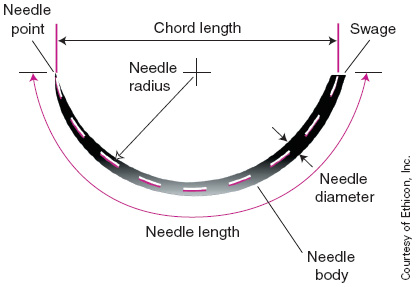
characteristics: eye, point, body, and shape
What are the classifications of eyes, the portion of the needle where the suture strand is attached
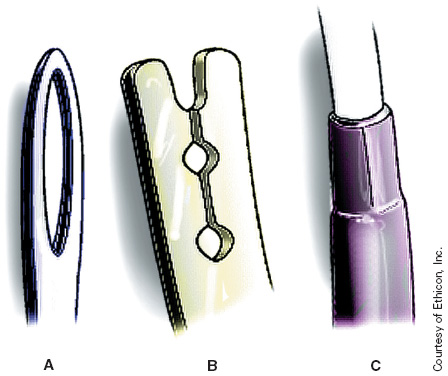
Closed-eyed
French-eyed
Eyeless (swaged)
What may have round or square holes and are loaded by inserting the end of the suture material through the hole
Closed-eyed needles
What is loaded by pulling the taut strand into a V-shaped area just above the eye. This type of needle is loaded more quickly than a closed-eyed needle, but still results in more tissue damage than the eyeless needle.
The French-eyed needle
What are needles that are manufactured with suture strands inserted into one end, and are continuous with the suture strand, and the hole created in the tissue by the needle should be completely filled by the suture strand when suturing.
eyeless or swaged needles
What may have a single-arm attachment or a double-arm attachment.
Eyeless needles
What is a single needle swaged to the suture strand. These may by used for interrupted or continuous suturing
single-arm attachment
Eyeless needle
What has a needle swaged to each end of the suture strand, and are commonly used for anastomosis of vessels, allowing the center of the suture to be sewn to the center of the vessel with one suture end sewn to the left and the other to the right. The stitches meet in the middle on the opposite side of the vessel
Double arm attachment
Eyeless needle
What points are available for needles
Cutting, tapered, or blunt
What needles are used for tough tissue that is difficult to penetrate. The sharp edges of this type of point actually cut the tissue as they penetrate it.
Cutting needles are typically used for the sclera of the eye, tendons, or skin.
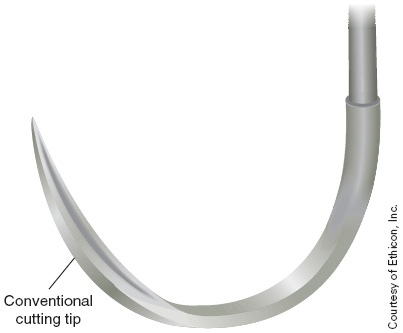
Cutting needles
What needle consist of opposing cutting edges in a triangular configuration that extend into the full length of the shaft. They are used for the skin because they have a flat edge in the direction of the pull. This results in less tearing of tissue.
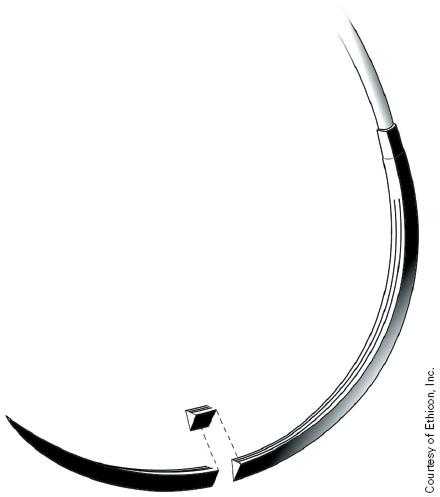
Reverse cutting needles
What needles are used primarily for ophthalmic procedures because they will not penetrate into deeper tissues and separate the tissue layers during placement.
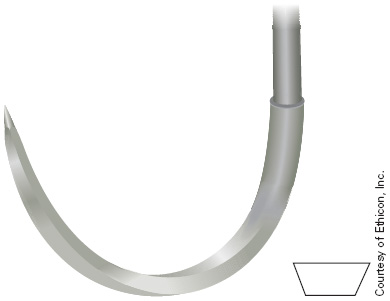
Side cutting needles
What needles have a round shaft without a cutting edge, so they penetrate tissue without cutting it. These points are used for delicate tissues, such as the tissue of the gastrointestinal tract.
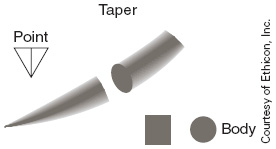
Tapered point needles
What needles have a round shaft that ends in a blunt tip. These points are used primarily for the kidney or liver due to the tissue being so friable or weak.
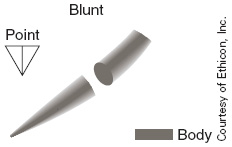
Blunt points
What is located between the suture strand and the point. Its size and shape are variable and choice depends on the type of tissue to be sutured. Typically, the heavier the tissue, the heavier the body
The shaft, or body
What determines the length of a needle
depth of the “bite” of the tissue to be sutured
What are used to inject medications into tissues or intravenous tubing. Needle lengths range in size from V to 4 in., and gauge sizes range from 12 to 30, with smaller needles having the larger gauge number.
Hypodermic needles
Which assemblies employ a needle to introduce a plastic indwelling catheter into a vessel (commonly called an IV in order to deliver IV fluids, blood, and/or blood products into the circulatory system).
Arterial or venous/cannula needle
The Potts-Cournand needle/cannula assembly, are used to introduce diagnostic or angioplasty guiding catheters over guiding wires into the arterial system. Venous needles with an aspirating syringe are used to puncture large veins for the introduction of monitoring catheters, such as the Swan-Ganz. Heparin needles attached to syringes
Arterial needles
What are not needles but a small-diameter cannulated tube attached to a plastic needle hub for placement on a syringe.
Irrigation needles
Which needles are used to obtain tissue samples from within the body for biopsy. This type of biopsy is sometimes guided with the aid of CT scan or fluoroscopy. Examples of this type of needle include the Dorsey cannulated needle for biopsy of cerebral tissue through a burr hole, the Chiba biopsy needle for biopsy of lung tissue through the chest wall, the Franklin-Silverman cannulated biopsy needle with a “trap door” tip for biopsy of the liver and other internal organs, and the Tru-cut biopsy needle
Large percutaneous biopsy
What are closed in layers. From inner to outer, these layers include the peritoneum, fascia, muscle, subcutaneous, subcuticular, and skin layers
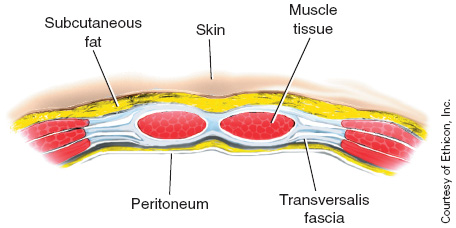
Abdominal wounds
What is a fast healing thin membrane lining the abdominal cavity
A continuous 3-0 absorbable suture is frequently utilized
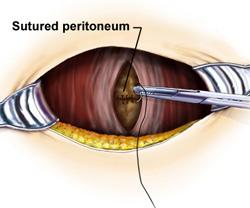
Peritoneum
What is a tough connective tissue covering the muscle, this layer heals slowly and must endure the brunt of wound stress; therefore, interrupted, heavy-gauge, non absorbable multifilament suture is preferred for added strength, and polypropylene surgical mesh may be used
Fascia
What is not typically closed with suture because they do not tolerate suture material, are usually separated or retracted and therefore do not need to be closed.
Muscle
What does not tolerate sutures well, a few interrupted sutures into this layer to prevent dead space, especially for obese patients. Plain gut is often the preferred suture material
subcutaneous tissue
What is an area of tough connective tissue just beneath the skin and just above the subcutaneous layer. Absorbable sutures are preferred, as they are often left inplace
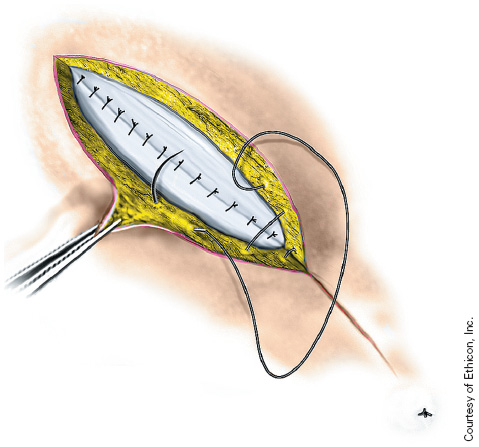
Subcuticular
What may be close with interrupted or continuous monofiliment, nonabsorbable sutures on a cutting needle or with skin staples. Polypropylene or nylon are the preferred suture materials; however, stainless steel staples result in less tissue reaction.
Skin
What is the main suture that approximates the wound edges for first intention healing to occur, typically placed in either an interrupted or continuous fashion
primary suture line
What suture is a primary suture line consisting of a single strand of suture placed as a series of stitches often used for closure of long incisions, strand is tied after the first stitch is placed at one end and tied again after the last stitch is placed at the other end. Evenly distributed tension along the suture line is a hallmark of the continuous suture closure
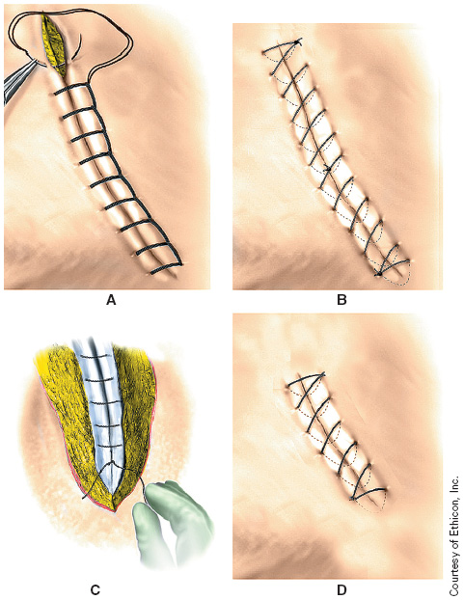
Continuous, or running,
What suture is used for long straight incisions when the wound edges easily evert
Simple Continuous
What suture is a variation of the simple continuous where the suture is locked prior to placement of the next throw
Continuous running/locking (blanket stitch)
What suture is a single suture technique at end of wound; multiple bites are made opposite each other the length of the wound
Subcuticular (First throw )
What suture is placed in a circular fashion around a structure in such a way that pulling on the suture ends tightens and closes an opening
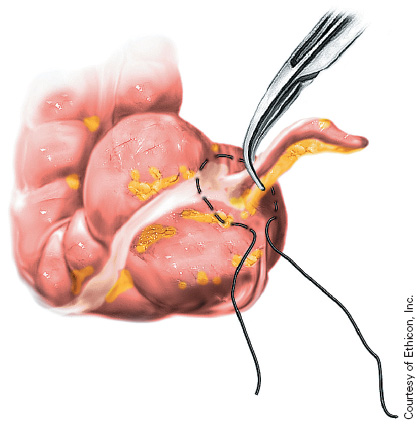
Pursestring (drawstring)
What is the suture technique of choice to close infected tissues, stopping the pathway of bacteria, localizing the area of infection to a smaller area of the wound, and is the technique of choice to close tissues that are under tension
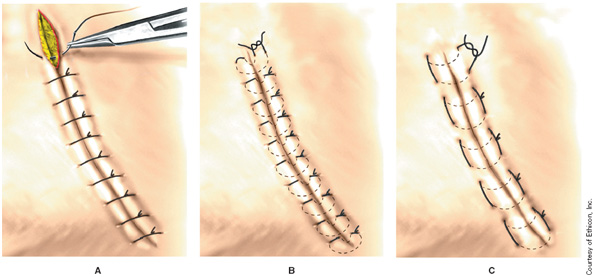
Interrupted suture
What Interrupted suture techniques are available
Simple
Interrupted horizontal mattress (parallel)
Interrupted vertical mattress (behind 1st bite)
Figure-of-8 Stick Tie
Buried
What sutures are used to retract a structure that may not be easily retracted with a conventional retractor instrument, a non absorbable suture is placed and the ends clamped with a hemostat.
Examples: sutures placed into the sclers of the eye, the myocardium of the heart or the tongue
Traction sutures
What is useful for support of the primary suture line. It helps to ease tension on the primary suture line
Secondary suture line
What are large-gauge, interrupted, nonabsorbable sutures placed lateral to a primary suture line for wound reinforcement. Used when wound may not heal or may be reopened due to coughing
Retention sutures
What suture method actually refers to creating the knot outside the body prior to instrument transfer through the trocar cannula to the tissue site.
Extracorporeal suture
Endoscopic
What method simply refers to the surgeon using instruments inserted through the trocar cannula to facilitate the internal suturing of tissues and knot tying
Intracor-poreal suture
Endoscopic
What is used to ligate tissue pedicles during endoscopic procedures. A suture is inserted through a long, thin plastic tube, which is formed into a loop with a knot. When ligature is in position, the tube is pulled upward to tighten the loop and knot.
Endoloop ligature
What is a single-use suturing device for the placement of interrupted or running stitches in soft tissue. The device has two jaws; the needle is loaded from a single-use loading unit; the needle can be passed between the jaws by closing the handles. The device also serves as the knot pusher to tighten the knot.
Endo Stitch
What is a noninvasive, atraumetic device used for skin closure. It combines a zipper and two lateral adhesive strips, be 3-4 cm longer than the surgical wound
Wound zipper
What is a synthetic adhesive used for skin closure; two commercial names are Dermabond™ (Ethicon product) and Indermil™ (Syneture product). A pencil-like device is held and a button on the side is pushed to deliver the chemical liquid glue, wears off in 7-10 days
Cyanoacrylate
What is a biologic adhesive and hemostatic agent, its mixed calcium chloride and produces a clot
Fibrin glue
What are plastic devices that help the closed incision. Retention suture ends are brought up through holes on each end of and tied at the middle. A circular tightening device allows tension to be adjusted on the retention sutures
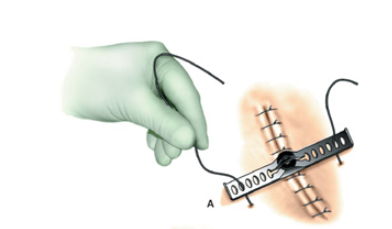
Bridges
What are pieces of plastic or rubber tubing threaded over the retention suture ends before the ends are tied. Once tied, they cover the retention sutures and prevent them from cutting into the skin
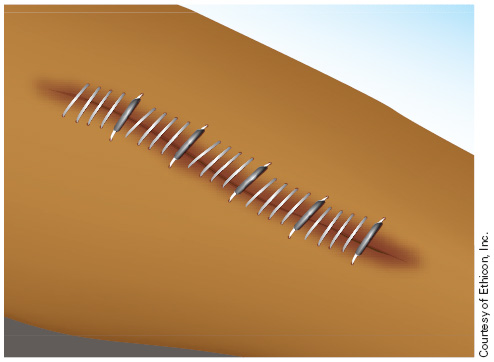
Bolsters
Tendon sutures may be pulled through ........ and tied over a ...... to prevent tissue damage. Split lead shots may be clamped onto the ends of subcuticular sutures after skin closure.
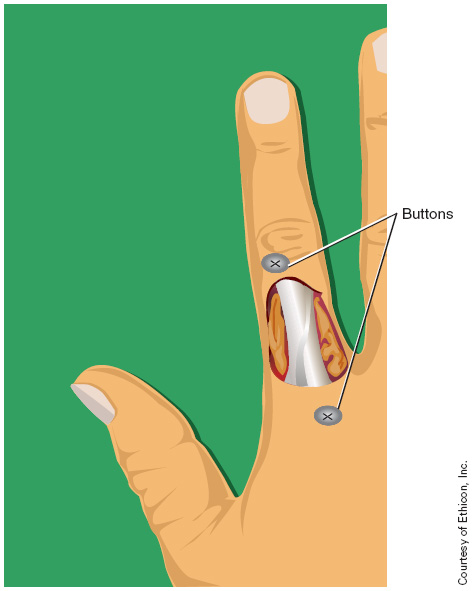
buttonholes / button
What was once used to ligate the severed ends of the umbilical cord after childbirth. It is used in the OR as a retraction and isolation device for bowel, nerves, vessels, or ducts. Umbilical tape is usually packaged with two strands in a pink packet and is best used moistened with saline and loaded onto a hemostat.
Cotton umbilical tape
What are used as isolation/retraction devices for vessels, nerves, or ducts. The elasticity of the vessel loops makes them ideal for retraction of delicate structures or for temporary occlusion of a vessel. Vessel loops are colored for easy identification of different adjacent structures. Typically, white and yellow loops are for nerves or ducts, red loops are for arteries, and blue loops are for veins. They are packaged in pairs.
Silicone vessel loops
What are used in orthopedic surgery for fixing tendons and ligaments to bone. The device consists of the anchor, such as a screw made of metal or absorbable material, that is inserted into the bone and an eyelet through which the suture passes
Suture anchors
What are adhesive-backed strips of nylon or polypropylene tapes used to reinforce a subcuticular skin closure or approximate wound edges of small incisions or superficial lacerations when sutures may not be necessary. Prepare skin with tincture of benzoin to help them stick
Skin closure tapes
What is a sterile liquid that is applied topically. It is used on the surface of a wound that will not be under tension in place of adhesive skin closure tapes, staples, or suture
Skin adhesive
Staples are frequently used during surgical procedures to anastomose or approximate tissue
Advantages:
Less tissue reaction
Accelerated wound healing
Less operating and anesthesia time
Efficiency
Stapling advantages over suturing
What are used to approximate skin edges during skin closure. The surgeon everts (turns outward) and approximates the skin edges with Adson tissue forceps with teeth and the operator positions the stapler at the approximated edges with the aid of an arrow located on the stapler head
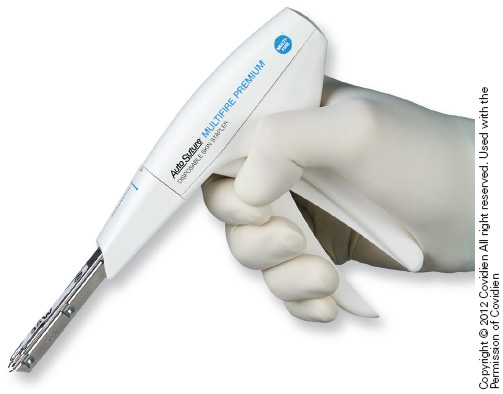
Skin staplers
What are used to insert two straight, staggered, evenly spaced, parallel rows of staples into tissue, used to staple tissue to be transected within the alimentary tract or thoracic cavity,
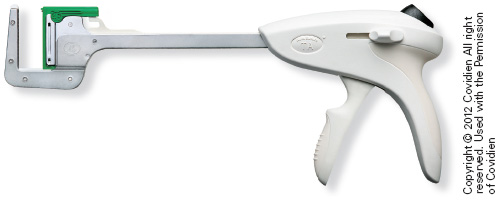
Linear staplers
What is used to staple and transect the tissue, and deliver two double staple lines, and contain a knife blade that passes between the two staple lines, dividing the tissue, especially useful during gastrointestinal procedures.
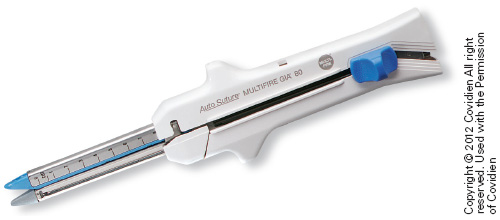
The linear cutter
What is used to occlude a single small structure, such as a blood vessel or a duct. A structure to be divided must have at least two individual clips placed (one or more proximally and one or more distally).
Ligating clip
What ejects two ligating clips side by side and then divides the tissue between the clips with a single activation. It is especially useful during gastrointestinal procedures for division of the greater omentum.
Linear dissecting stapler
What are used to anastomose tubular structures within the gastrointestinal tract. This stapler fires a double row of circular staples and then trims the lumen with a knife located within the head of the stapler
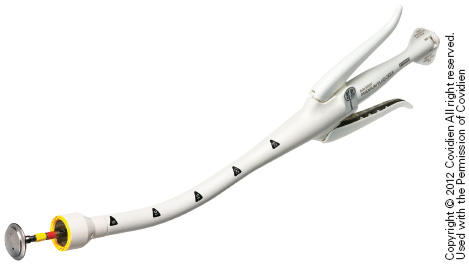
Intraluminal (circular) staples
What can be used as a bridge for tissues that cannot be brought together without placing a great deal of tension on the tissues, and may also be used as a reinforcement for fascia defects
Examples:
Polypropylene mesh – relatively inert material, can be used in presence of infection
Synthetic mesh
Which is the least inert of the synthetic meshes, never be used in presence of infection, its multifilament fiber construction can harbor bacteria
Polyester fiber mesh
What is rigid, hard to apply, resulting in discomfort for the patient. It is the most inert of mesh materials
Stainless steel mesh
What is a soft flexible mesh, not absorbable, should not be used in presence of infection
Polytetrafluoroethylene (PTFE) mesh
What is an absorbable material that provides temporary support during healing
Polyglactin 910 mesh